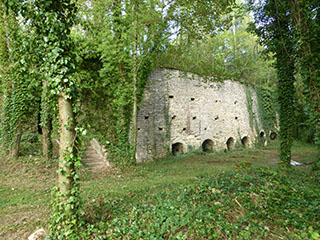Prochain point : lat="49.1647" lon="1.84934"

Quarries and Lime kilns
Two activities that led to the economic and demographic growth of the town
Limestone taken from the quarries...
At Nucourt, the geological formations are mainly from Tertiary period (65 to 2.6 million years ago). The different layers are composed of limestone, marl, sand, and silt. For a long time Nucourt exploited its subterranean riches, extracting limestone from underground quarries. The cut stone and rubble were primarily used to build houses. In the early twentieth century, mushroom cultivation replaced stone extraction, which had become less profitable because of competition from other materials. During World War II some of the quarries were used by German soldiers to set up an assembly line for the V1 flying bombs, considered to be the first cruise missile in aviation history. During the summer of 1944, the Allies bombed the town three times with 6000 perforating bombs. Nucourt was largely destroyed and eight people were killed.
... To be fired in the lime kilns
Limestone is transformed into lime by calcination. After cooking, the limestone rubble loses its carbon dioxide and turns into quicklime. Slaked lime is mixed with aggregate to produce mortar. This process was carried out in lime kilns. The kiln stoker and his team were responsible for maintaining the temperature between 800 and 1000 ° C while keeping the furnace filled with limestone rubble and charcoal. The arched openings provided access for stoking the fire. Once fired, the lime was removed through a low opening at the rear of the kiln. The quicklime was slaked in a nearby pit with large quantities of water. The furnaces finally stopped operating in 1939.





